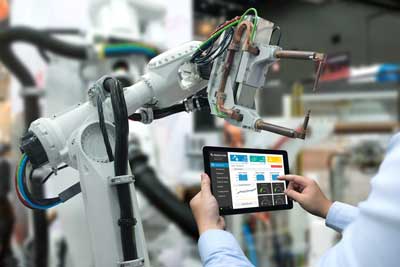Smart manufacturing and the IoT is driving the next industrial revolution

Smart manufacturing and the IoT is driving the next industrial revolution. Manufacturing is on the cusp of a revolution – the Internet of Things (IoT) revolution! In 2016, IDC estimates the manufacturing segment invested $178 billion(€152.89 billion) in IoT spending, twice as much as the transportation segment, the second largest IoT vertical market.According to Markets and Markets Research, the smart factory market is projected to reach 205.42 Billion USD by 2022, growing at a CAGR of 9.3% between 2017 and 2022.
In this fiercely competitive market, IoT-enabled smart manufacturing provides full visibility of assets, processes, resources, and products. This, in turn, supports streamlined business operations, optimised productivity and improved ROI. The key to success is connecting equipment, integrating diverse industrial data, and securing industrial systems for the entire lifespan of equipment.

For two decades, Gemalto has been a trusted partner, helping customers Connect, Secure and Monetise their enterprise operations with IoT technology. In this web dossier, we’d like to share some of the best practices we’ve gathered to help companies interested in making the leap to “Industry 4.0.”
What is smart manufacturing and how is it related to the IoT?
Smart manufacturing allows factory managers to automatically collect and analyse data to make better-informed decisions and optimise production. The data from sensors and machines is communicated to the Cloud by IoT connectivity solutions deployed in the factory. That data is analysed and combined with contextual information and then shared with authorised stakeholders.
IoT technology, leveraging both wired and wireless connectivity, enables this flow of data, providing the ability to remotely monitor and manage processes and change production plans quickly, in real time when needed. It greatly improves outcomes of manufacturing reducing waste, speeding production and improving yield and the quality of goods produced.
Replacing the hierarchical structure that has historically defined the “shop floor” with an open, flatter, fully-interconnected model that links R&D processes with supply chain management has many benefits, including the optimisation of global manufacturing processes related to performance, quality, cost, and resource management. It also enables the manufactured products themselves to play a key role in development and design of the manufacturing process.
This is because connected smart products are able to feed information back to the factory so that quality issues can be detected and fixed during the manufacturing stage by adjusting product design and/or the manufacturing processes. Smart products can also provide insights on how they are actually used by consumers, providing the opportunity to adapt features to better meet the real needs of the marketplace.
How is the manufacturing marketplace evolving?
The manufacturing sector is being fundamentally reshaped by the unstoppable progress of the 4th Industrial Revolution, powered by the IoT. The changes to this segment are made possible by technological breakthroughs that are occurring at an unprecedented pace.
Just as the steam engine ushered in massive changes in the early 17th Century and the advent of the digital age rocked the world in the second half of the 20th century, today’s technological innovations are forcing decision makers to reimagine how products are designed and produced. In addition to the IoT, consider how Artificial Intelligence (AI), machine learning, and Virtual Reality (VR) will impact manufacturing.
This IoT revolution is expected to profoundly increase productivity and value. This is why the world’s largest manufacturers, China, the US and Europe, have launched dedicated initiatives to bolster their own manufacturing sector. In essence, these manufacturing leaders are engaged in a global battle for smart manufacturing competitiveness.

The expectation is that all types of manufacturing have something to gain from the 4th industrial revolution and the IoT. For instance, discrete manufacturing is the production of distinct items that can be individually touched and counted and are typically associated with assembly lines. This includes items such as cars, furniture, and airplanes, that are increasingly connected.
Smart processes will play a prominent role in balancing supply and demand, improving product design, optimising manufacturing efficiency and greatly reducing waste. Similarly process manufacturing where goods are produced in bulk using carefully crafted recipes, gains from the IoT revolution in terms of improved plant monitoring, a streamlined supply chain, and quality improvements in track and trace and distribution processes.
Why is security a huge concern in smart manufacturing?
Today, the manufacturing sector is the leading victim of infrastructure cybercrime, accounting for one-third of all attacks.3That’s because most conventional manufacturing plants were not designed with cybersecurity in mind, and because hacking technology has become increasingly sophisticated.
As manufacturers migrate from traditional factories to IoT-connected, IP-based systems, new vulnerabilities emerge. Inherent in connecting processes and elements of smart manufacturing is an expansion of the cyber attack surface. Each point of connection becomes an added risk of attacks and cybercrimes that can lead to interference, remote access, theft of intellectual property, and data loss or alteration.
Although many tried-and-true security tools remain effective, they are not always planned into systems from the beginning. To assure adequate security, manufacturers must adapt by building in defensive measures to legacy equipment and systems that are now connected. And they must consider security architecture from the beginning for new, state of the art manufacturing centers.
Security challenges have also slowed the pace of adoption of new IoT technologies, organisational changes, and business models that could immensely improve processes, enhance competitiveness and bring new services to customers. Unfortunately, enterprises that do not keep pace will find it more difficult to compete with their more forward-thinking counterparts who are tackling the challenge head-on.
What should industry players consider as they transform manufacturing to smart manufacturing?
To stay competitive, manufacturers need to partner with manufacturing automation vendors and systems integrators that provide solutions to upgrade factories or build new systems from scratch. Strong automation partners are adding security architecture to the value chain since they know this is a major concern for manufacturers and a key to competitive advantage in the marketplace.
Manufacturers should work with experienced integrators, developers and technology partners who have already exhibited excellence and longevity in connecting, securing and monetising smart manufacturing systems. Experienced partners can provide the direction needed to develop the best system to meet business needs.
For instance, manufacturing processes can be connected by hard wiring, WiFi, Bluetooth, RFID, Low-Power Wide-Area Networks including LoRa and LTE M, and even IoT Terminals that work out of the box and connect via flexible industrial interfaces. Each has different strengths and ideal use cases and a strong partner with experience in connecting smart manufacturing systems can help decide which solution is best for individual use cases.

They must also consider security and how to protect smart manufacturing systems from intrusion or error. For instance, Gemalto Secure Elements and Hardware Security Modules (HSM) are used to secure product manufacturing systems. SEs and HSMs allow manufacturers to generate and distribute IDs and certificates for devices and they authenticate devices, users, and applications that interact with devices. They also help secure communication and protect data at rest.
Similarly, Trusted Key Manager (HSM) plays a key role in security. TKM manages credentials for LoRa devices and networks as well as IoT devices not connected to a cellular network, historically a challenge for manufacturers. The TKM solution allows manufacturers to decouple these credentials from the production process, making the business scalable and preserving trust between manufacturers and customers.
Another area for industry players to consider is successful software monetisation. Licensing and IP protection is an important component in manufacturing industrial devices, which includes more and increasingly complex software, trade secrets, and pricing models based on usage and variable feature sets.
What should stakeholders do to secure their smart manufacturing facilities?
Security measures must be embedded into all manufacturing systems from the outset, enabling failsafe production and protection against cyber threats. There is no one-size-fits-all solution. Instead, manufacturers must work with experts to protect and defend the device, the network, the data and the software solutions and applications driving IoT smart manufacturing systems. Gemalto offers services and solutions that provide recognised end-to-end security, whatever the connectivity means – from cellular to LPWAN to fixed networks.
The potential for smart manufacturing is enormous and should not be hampered by security doubts. Industry leaders must develop trust when creating or retrofitting smart factories. It is imperative that solutions be carefully and scrupulously selected and recognised for stellar performance. Because of the long life cycle of manufacturing equipment, it is also critical that chosen solutions have built-in flexibility and advanced over the air updating solutions in place to prevent threats today and well into the future.
Comment on this article below or via Twitter @IoTGN
